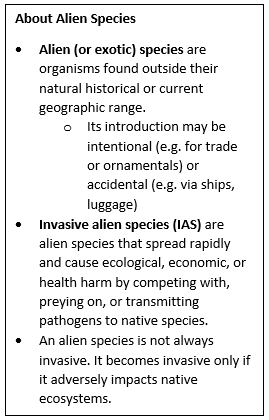Syllabus
GS 3: Environment
Context:
A recent study in Nature Reviews Biodiversity shows that non-native (alien) plant species are quickly spreading in tropical regions.
More on the News
- It has started replacing native plants and causing lasting damage to the ecosystem.
- Climate change and human activities are making the spread of foreign plants worse, threatening biodiversity and livelihoods in the Greater Tropics.
- The study calls for urgent research and restoration efforts to reduce these harmful impacts.
Key Highlights from the Study

- New research in Nature Reviews Biodiversity shows that invasive plant species have spread widely across the world. In many areas, they are now more common than native plants.
- The study also found that climate change and human activities are speeding up the spread of these alien species, creating new and unpredictable changes in ecosystems.
- Researchers focused on the tropics and subtropics, together called the ‘Greater Tropics’. This region covers about 60% of the Earth’s land and holds most of its biodiversity.
- Around one billion people rely on the Greater Tropics for their livelihoods.
- Endemic hotspots like Hawaii, Madagascar and the Caribbean have been heavily impacted by thick invasions of non-native plants.
- The review focuses on terrestrial vascular alien plant species, which make up 75% of all known alien species.
- Since the 1950s, the spread of alien plants has increased rapidly.
- Currently, 4% of all plant species (about 13,939 to 18,543) have settled outside their native regions. The Greater Tropics alone has around 9,831 alien plant species.
- Many of these may still be in the early phase of invasion, with potential to spread further.
- The study found that 26% of islands globally have more alien plants than native ones.
For example:
- Guam: 66.5% alien plant cover
- Tahiti: 73.8% alien flora
• Endemic-rich areas like Hawaii, Madagascar, and the Caribbean are severely affected by thick plant invasions.
• While invasion hotspot patterns are not fully clear, invasions are more common in areas with:
- Moderate climate
- High productivity
- Human land use changes
• Regions like the Mediterranean and South Asia face higher levels of invasion.
• Invasive species such as Lantana camara, Sonchus oleraceus and Chromolaena odorata thrive in such environments and have become pan-tropical invaders.
Future Speculation on Alien Species
- By 2050, the number of alien plant species is expected to rise by about 21% (669 species) in South America, 12% (503 species) in Africa and 10% (227 species) in the tropical regions of Asia.
- The study says that plant invasions are likely to increase in South America, West Africa, coastal Asia, and Southwest China under some future scenarios.
- Scientists say these predictions are likely underestimates because control measures are weakening and global environmental changes are speeding up the spread.
- They explain that climate change, mostly caused by human activities, is creating favourable conditions for alien plants to grow.
- More extremely hot days and deadly heatwaves are causing forest dieback in wet regions like the Amazon and are also making droughts worse.
Invasive Patterns in Africa and India
- 21% of alien species in Africa come from other parts of the same continent.
- Native woody plants like Vachellia karroo and Terminalia sericea are invading African savannas due to old plantations and rising CO₂.
- In India, woody thickening in savannas and open forests is causing more forest fires which then make way for future plant invasions.
- This forms a positive feedback loop — fires promote invasions, and invasions cause more fires.
Negative Impact on Native Wildlife
- Invasive Prosopis juliflora reduces native plants in semi-arid India.
- During dry seasons, animals like blackbuck eat its pods and spread its seeds.
- This helps the alien plant grow further and causes a decline in native plants.
Recommendations by Scientists
- A long-term, interdisciplinary study is needed to understand these impacts.
There is a need to:
- Improve documentation
- Raise community awareness, especially in the Global South
- Support ecosystem restoration across the Greater Tropics
Mains Question
Discuss the impact of invasive alien plant species on tropical ecosystems. How are climate change and human activities contributing to their spread, particularly in regions like South America, Africa, and tropical Asia? Suggest suitable measures to mitigate this challenge. (15M, 250w)

